1. Introduction
The purpose of the Project Portfolio is to document and showcase my contributions to the software project, EzWatchList
Our team was initially tasked with enhancing a basic command line interface(CLI) desktop application for our Software Engineering project. We are also allowed to morph it to other application that uses command line interface. Thus, we chose to morph it into a movie records management system called EzWatchList. This enhanced version provides a unique, clean and simple way of organizing and keeping track of movie or TV show watch list.
1.1 Overview
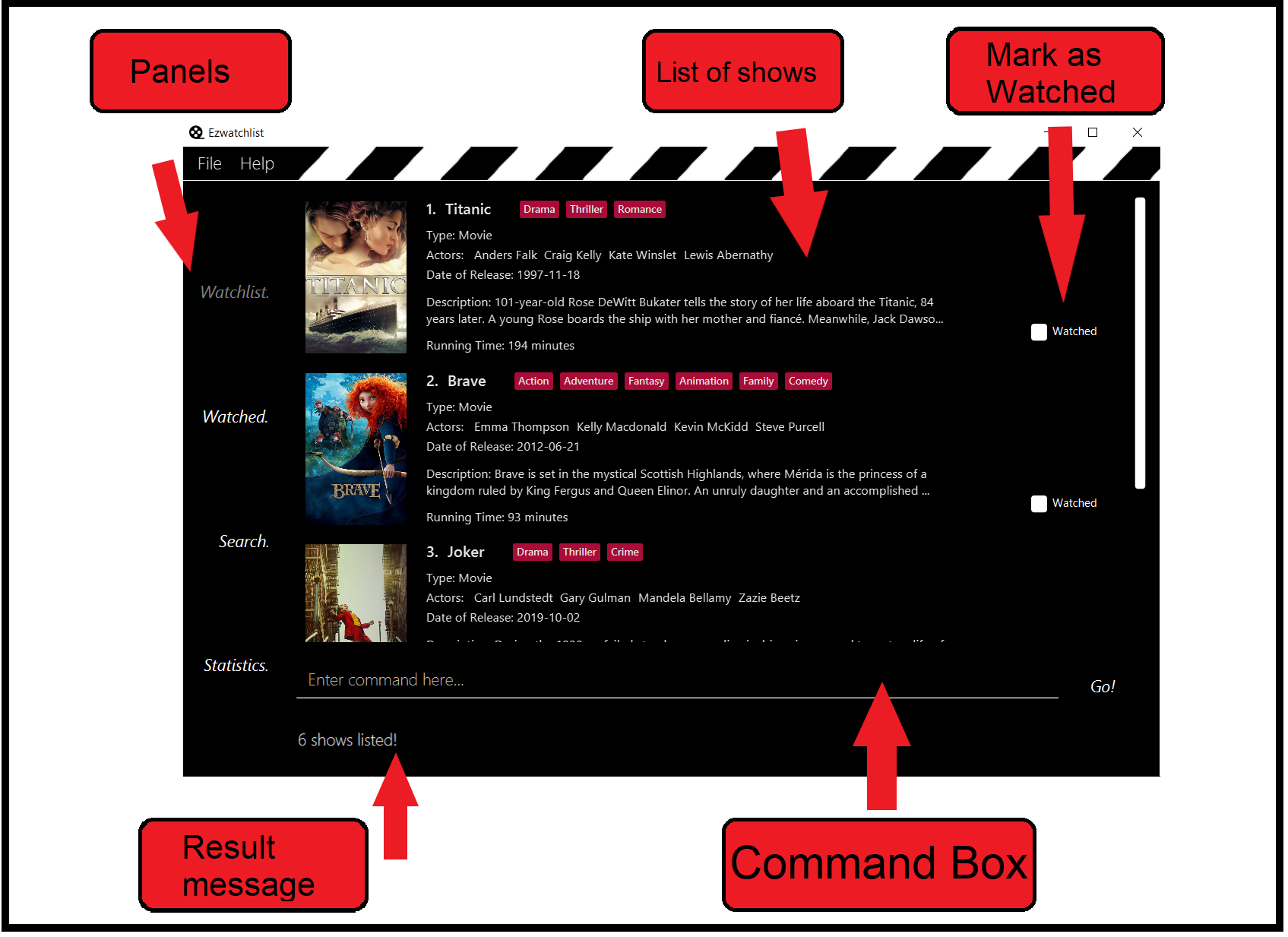
Figure 1. The graphical interface for Ezwatchlist.
EzWatchList helps users to keep track and organise movie or TV show in a watch list. User can simply
interact with the application by inputting commands into the interface.
Main features of EzWatchList:
-
Keep track of shows that users plan to watch
-
Allows users to edit and mark down shows that they have watched
-
Allows users to search for show online using
searchonline function or search within user’s watch list. -
Gives users statistics about their watching habits and recommend shows to them.
The following sections illustrate these enhancements in more detail, as well as the relevant documentation I have added to the user and developer guides in relation to these enhancements.
Interpreting Symbols
The table below shows a summary of the symbols used and their respective meanings.
| Symbol | Meaning |
|---|---|
|
Commands and Components of the Project |
Tips for the user |
|
Additional information |
2. Summary of contributions
This section shows a summary of my challenges, coding, documentation, and other helpful contributions to the team project. |
My role was to design and implement the Add and Sync features. These commands are essential to the application as they are the
building block of the application. Before I can design these features, I have to understand
the application requirement first such as functional and non-function requirements. I also have to know who my target audience
is and study the use-cases properly to plan out and design these features.
2.1 Major enhancement:
Added add and synchronise, sync, commands.
1. Modifying and extension of add command
What it does:
There are two separate functions for Add command.
First, it allows the user to add movies or TV shows into the watch list.
User has to input several information of the show such as name, description, and
name of actors.
Beside this core function, the add command also allows user to add a movie found in search
result page after user has used the search online feature. Search page displays the search result of the movies the user
is interested to watch. The search feature is implemented by my team mate, Michelle.
Justification:
The purpose of this application is to allow user to track movie list. Thus, adding shows into watch list is a
fundamental and core function that runs the application. If the user wants to know more about a certain movie, he can
simply use the search function to search for it. The search function is able to gather information about movies online
and user can choose to ‘add’ a certain movie from the search list into his own watch list.
Highlights:
The addition of add command requires some understanding of both the implementation of the application and how to retrieve
the data from 3rd party API(TMDB).
Credits:
Since we are retrieving information on shows online, we have decided to use The Movie Database (TMDB) api.
2. Synchronise, Sync, command
What it does:
User may not have updated information about the show they want to add. They can use the search function to check the
details of the show they are interested to watch. Then, they are able to use the sync to synchronise a show found in
search page to their show which has already been added in watch list.
Justification:
User will definitely not know most of the information about a show. Hence, by implementing this sync function, users
will then be able to get updated information about the show.
Highlights:
This enhancement requires some understanding of both the implementation of the application and how to retrieve the data from 3rd party API(TMDB).
Credits:
Since we are retrieving information on shows online, we decided to use The Movie Database (TMDB) api.
2.2 Minor enhancement:
Added shortcut keys to move about pages easily.
What it does:
Users are able to press a single shortcut key button to move about the panels such as ‘Watchlist’, ‘Watched’, ‘Search’ and ‘Statistics’ without moving and clicking mouse.
Justification:
Our target user is one who prefers to type fast and complete tasks quickly. One of the non-functional requirement is to reduce the usage of the mouse as this is mainly a command line application. Adding shortcut keys will reduce the usage of the mouse.
Highlights:
This addition make it a lot easier for user to navigate through the different pages.
Code contributed:
My contributions to EzWatchList can be found in the following My Code Contribution
2.3 Other contributions:
Project management:
-
I am in charged of testing, so my responsibility is to plan, understand and write test codes for this project.
-
My job is to understand the component logic as well so I am analyse the problems faced better.
Enhancements to existing features :
-
I have added multi-threading when the user uses
searchcommand. Since, it might take some time to load the data, multi-threading allows the application to process these data in the background. Users will then be able to do other task in the application like usingaddcommand as well. -
I have added shortcut keys so users are able to navigate the pages easily.
-
Since I am in charged of the unit testing, I have added test cases to improve test coverage.
Documentation:
Community:
Tools:
-
Integrated a third party library (TMDB) to the project (TMDB Api)
3. Contributions to the User Guide
This section is an excerpt from our EzWatchList User Guide, showing additions that I have made for the sync features. They showcase my ability to write documentation targeting end-users. |
Synchronise user's show data: sync
If user has lack of information about a certain show in their watch list, User can use sync command.
Synchronise, sync, command will transfer all the information about a certain show (for example: show A) found in
search result page with a show (for example: show A') that has the same name as Show A found in watch list.
Note:
-
The show in the watch list must have at least a name and type.
-
Names are not-case sensitive.
-
Syncwill WRITE OVER all the information of show with same name found in watchlist.
Format: sync INDEX
INDEX is a positive integer and is limited to the number of shows found in search result page.
Example Usage
Scenario 1: User has already input 'Titanic' show into watchlist manually.
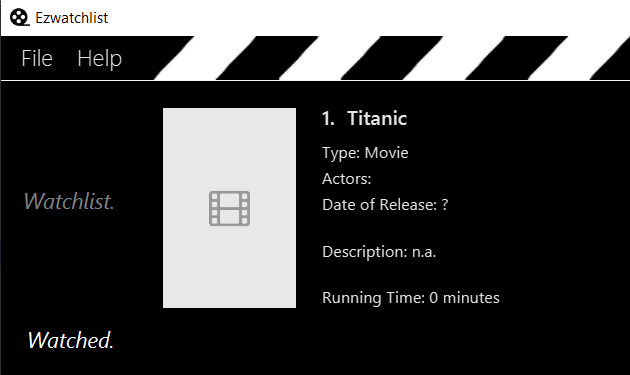
Step 1. User searches for Titanic show in search page.
Step 2. Titanic result page will be displayed. User input sync 2 to synchronise movie at index 2 of the list with a movie
of same name found in watchlist.
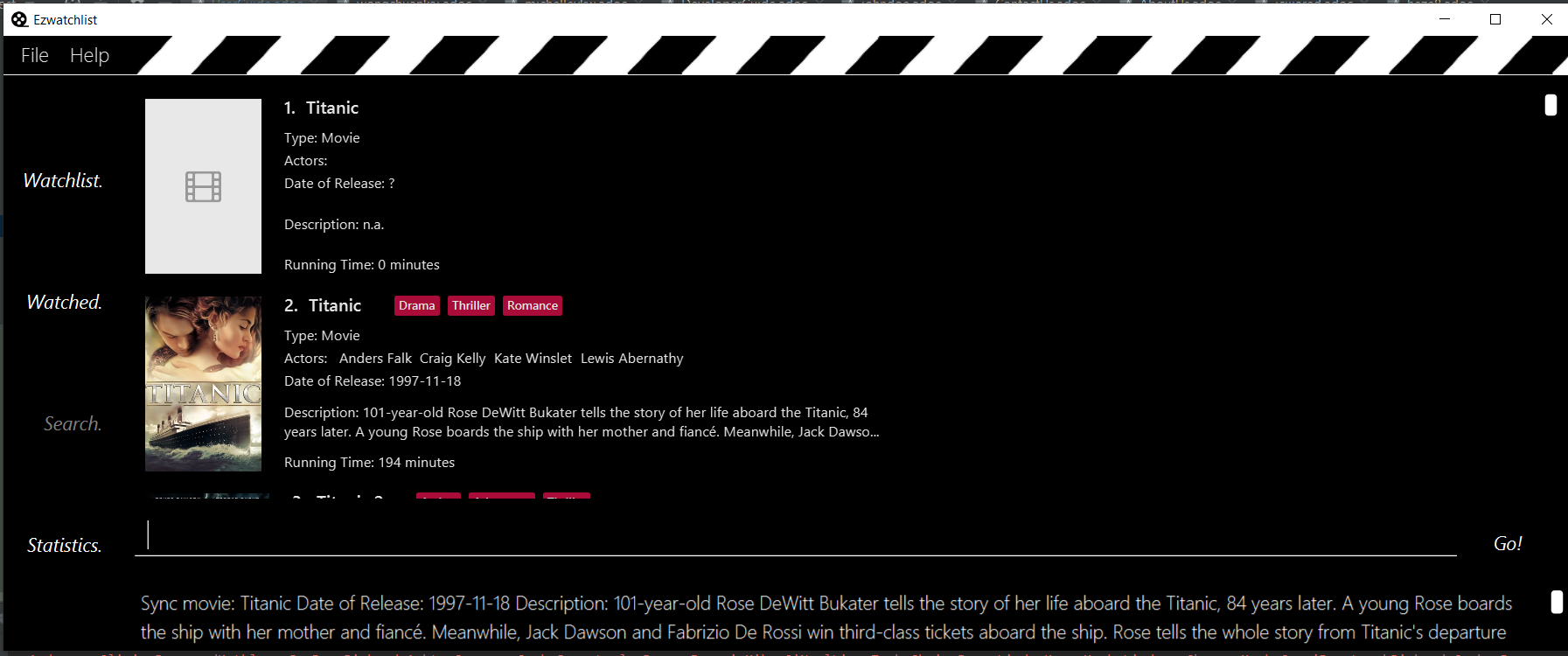
Step 3. Go to watchlist. New information of Titanic in watchlist will be displayed.
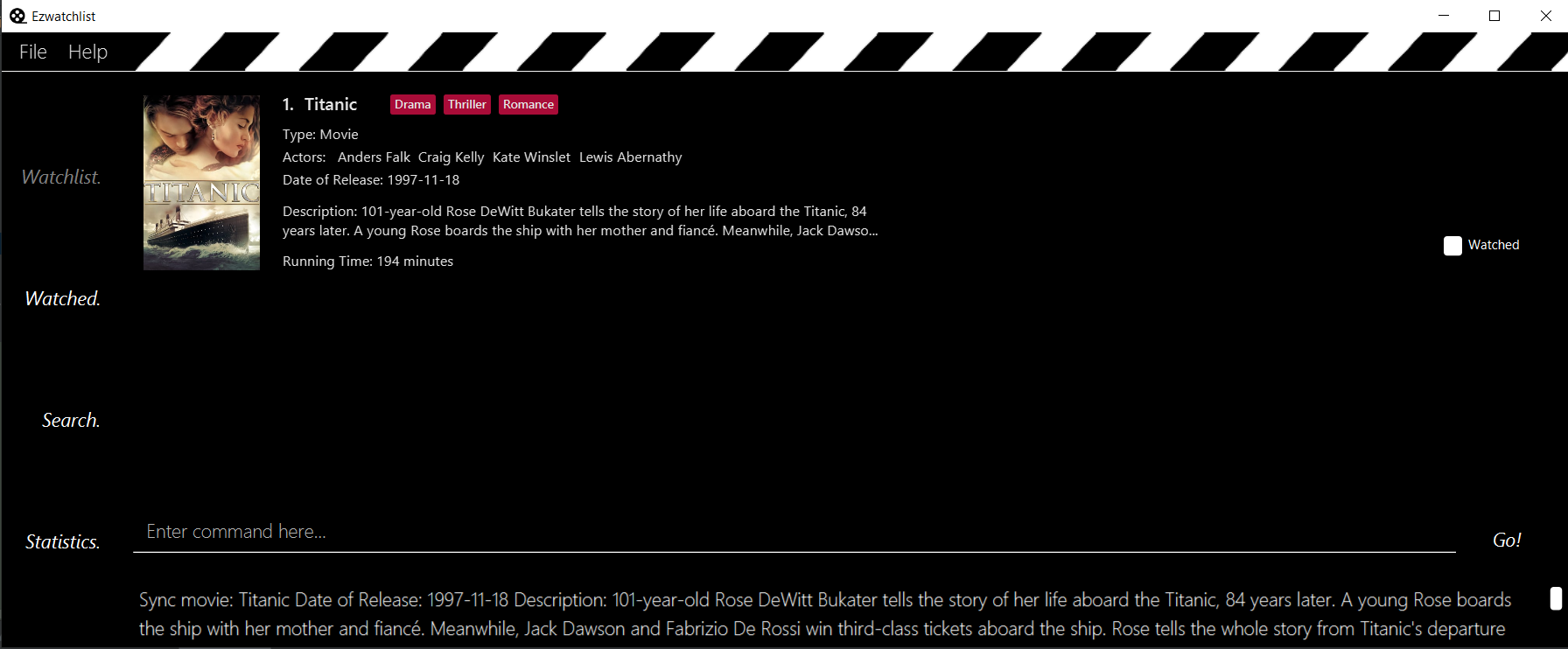
Scenario 2. User has not input Titanic show into watchlist manually.
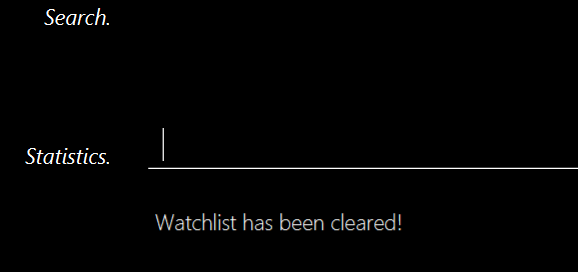
Step 1. Similar to scenario 1, user searches for Titanic show in search page.
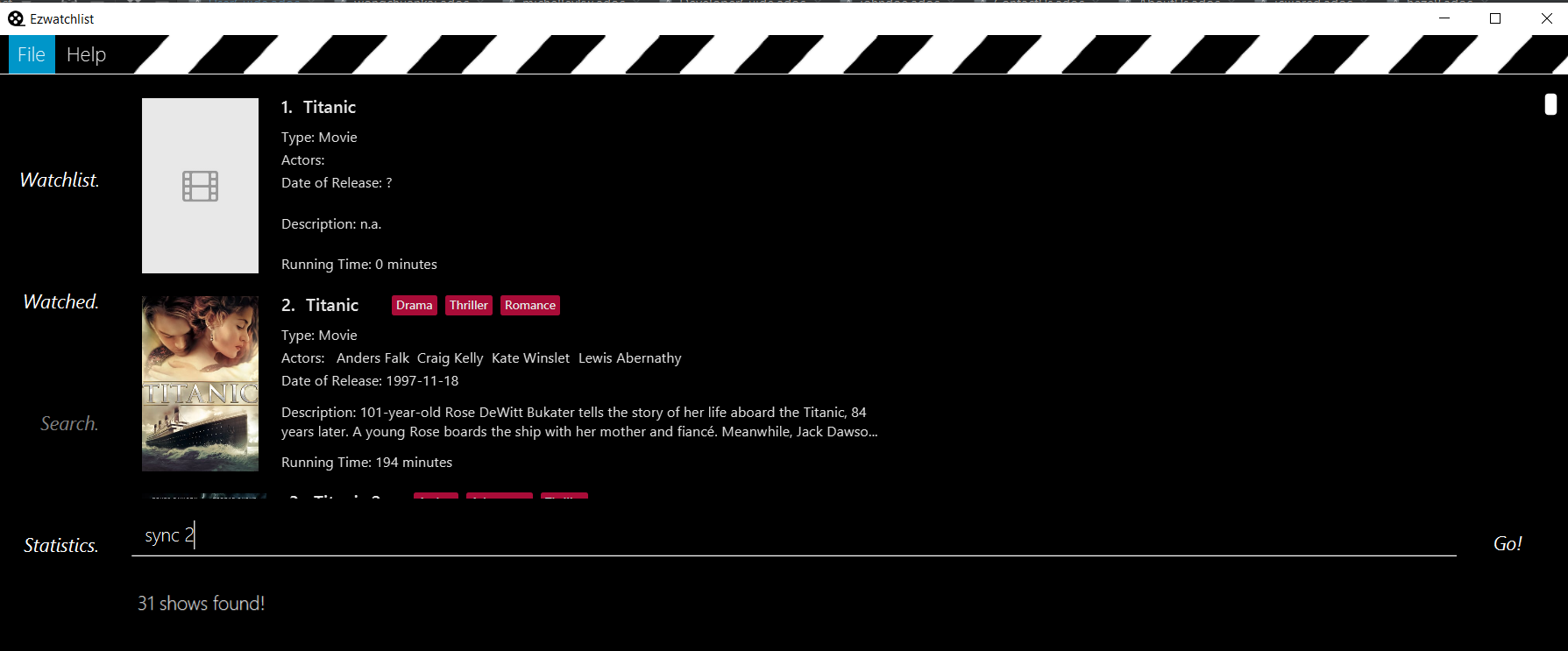
Step 2. Titanic result page will be displayed. If user were to sync any index, error message will be displayed
because there is no show of similar name found in watch list.
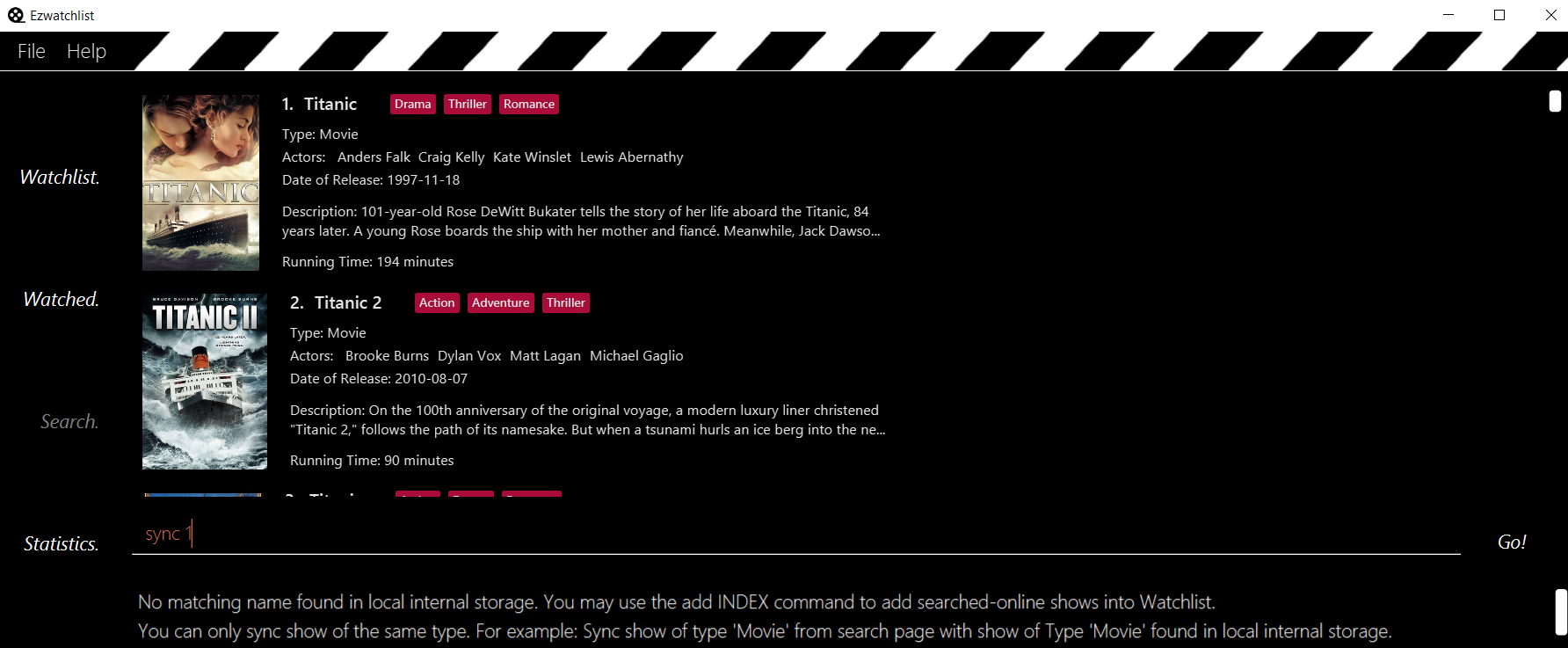
Step 3. User can choose to use add 1 command to add show of index 1 found in search result page.
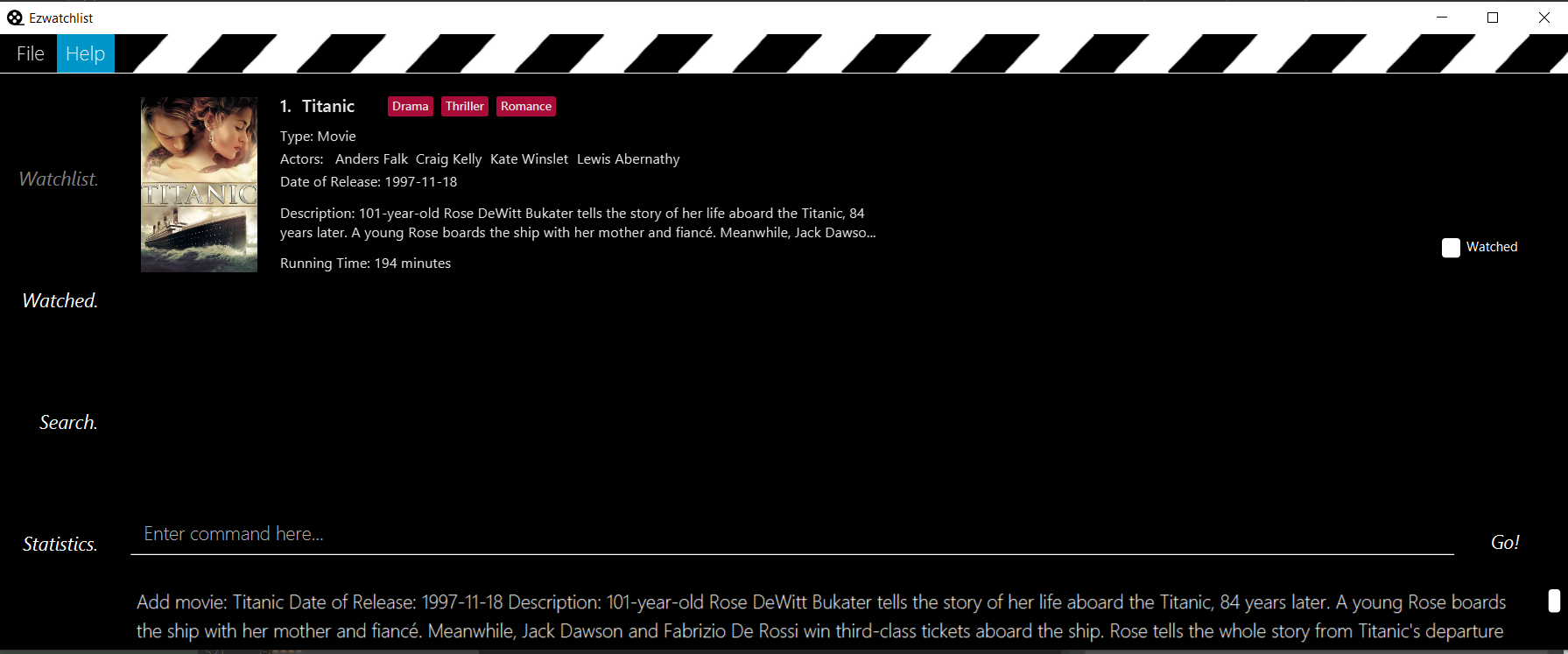
Contributions to the Developer Guide
Given below are sections I contributed to the Developer Guide, showing additions that I have made for the add and sync features. They showcase my ability to write technical documentation and the technical depth of my software engineering skills to the project. |
[Feature] Add feature (Extension)
Implementation
This add feature is an extension to the add feature found in previous feature.
It is used after user has searched for a show using search feature and the user wants to add a certain show
into his watchlist.
Given below is an example usage of add feature (Extension) and how the add mechanism behaves at each step.
Step 1. The user uses the search(Online) command and executes add INDEX command to add a show from search result page of INDEX in the WatchList.
Step 2. Entering the command calls AddCommandParser#parse().
Step 3. A new AddCommand is created, with the show to be added in AddCommand.
Step 4. The AddCommand#execute() method is called, referencing the current model and add the show given by user to the searchList of INDEX found in model.
The following sequence diagram shows how the add extension operation works:

The following activity diagram summarises the workflow of Add extension:
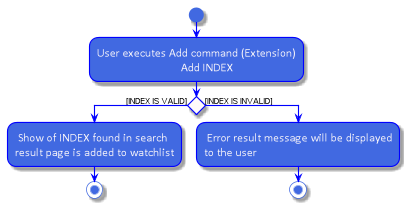
Figure 4: Activity Diagram of `AddCommand`
In Figure 4, User input search(online) command. User then input add INDEX command. Show of INDEX found in search result page is added to WatchList.
Design Considerations
Aspect: How AddCommand executes
-
Current choice: Retrieve the show object found in
searchListof INDEX from ModelManager and add it tofilteredShowList. -
Pros: Enables for greater cohesion since there is a specific command for adding information of a show in watchlist.
-
Cons: Requires longer code, and the code is also repetitive since its implementation is similar to that of the add and edit command
-
Cons: May have performance issues in terms of memory usage.
[Feature] Synchronise user’s show data
The synchronise feature allows user to sync a show found in watchlist with online searched show data. It modifies all of the
parameters/information is user selected show with online searched show data.
User may have added their show with their own information. However, user might not know some of the parameters such as actors.
Thus, user can use the search online command search n/ to look up information regarding that show.
Then, Synchronise command sync can be used to update information/modify on that show.
Implementation
The Synchronise feature is facilitated by SyncCommand object which can be found under the commands package.
It extends Command and uses the SyncCommandParser to process the command entered by the user.
Given below is an example usage scenario and how the Synchronise command work as Sync mechanism works at each step.
Pre-Condition: User has already added a certain show into watchlist manually. That show must have at least name and type parameters.
Example of Pre-Condition: User has added Titanic movie into watchlist.
Step 1. The user launches the application, go to Search page and execute search n/titanic.
Step 2. The user execute sync 1 command to synchronise index 1 of result page with a show in watchlist with same name (case-insensitive).
Step 3. Entering the command calls SyncCommandParser#parseCommand(), which in turn returns a new SyncCommandParser and the SyncCommandParser#parse() command is called.
Step 4. A new SyncCommand is created, with the index of the show being parsed as a field of the SyncCommand.
Step 5. The SyncCommand#execute() method is called, referencing the current model, and the show that is in the current FilteredShowList is referenced based off the current model.
If the index is out of bounds, a new CommandException is thrown.
|
Step 6. A list of shows found in search page and watchlist are retrieved from model. The show according to the Index of the searchpagelist are retrieved as well.
Then, the list of show in watchlist will be checked through to match the name of the index show.
Step 7. If a show in watchlist matched with the name of the index show, model.setShow will be called to replace the show found in watchlist with index show.
CommandResult will be return which contains information regarding the feedback result. Else, CommandException is thrown to notify user no similar show name is found in watchlist as index show.
The following sequence diagram shows how the sync operation works:
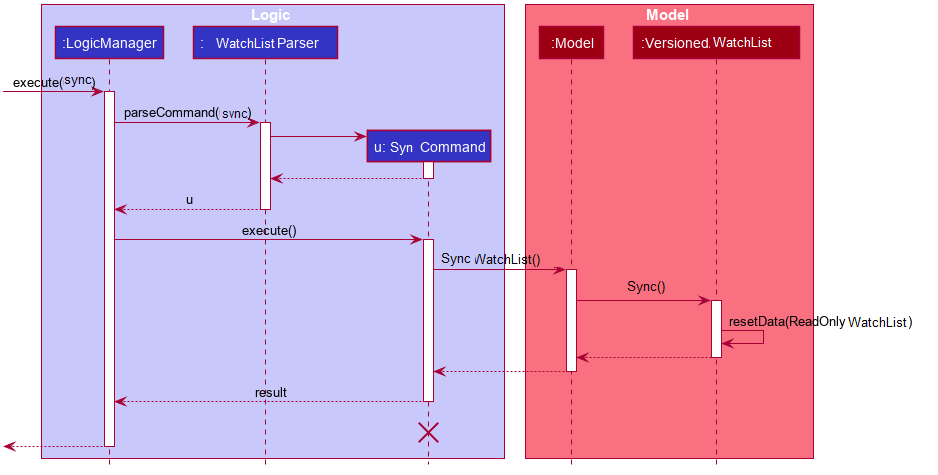
The following activity diagram summarises the workflow of Sync:
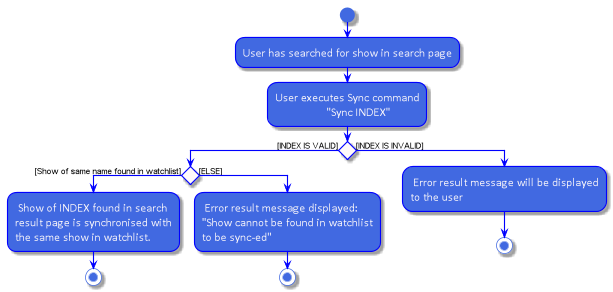
Design Considerations
Aspect: Creating a new Synchronise instead of an altered EditCommand and AddCommand
-
Alternative 1 (current choice): Creating a new Synchronise class for replace information of a certain show found in search page with one in watchlist.
-
Pros: Enables for greater cohesion since there is a specific command for replacing/modifying information of a show in watchlist.
-
Cons: Requires longer code, and the code is also repetitive since its implementation is similar to that of the add and edit command
-
-
Alternative 2: Use the SyncCommandParser to create a new EditCommand object that edits the information of a certain show found in search page with one in watchlist.
-
Pros: Less code repetition and shorter code in general.
-
Cons: This will mean that there is less cohesion of the code and perhaps greater dependencies since more classes depend on the EditCommand class.
-